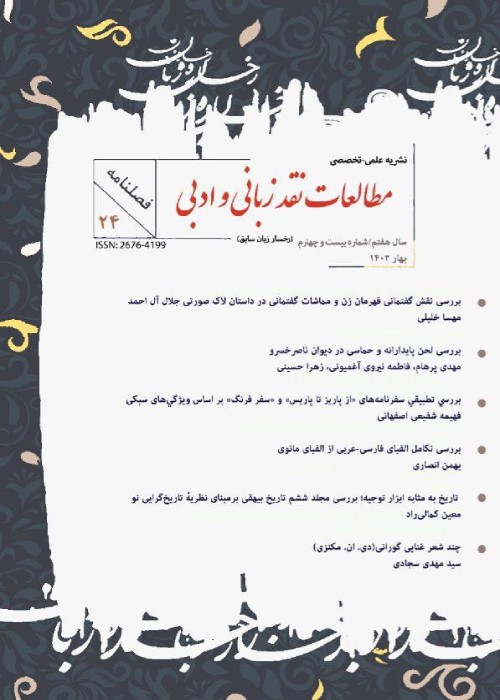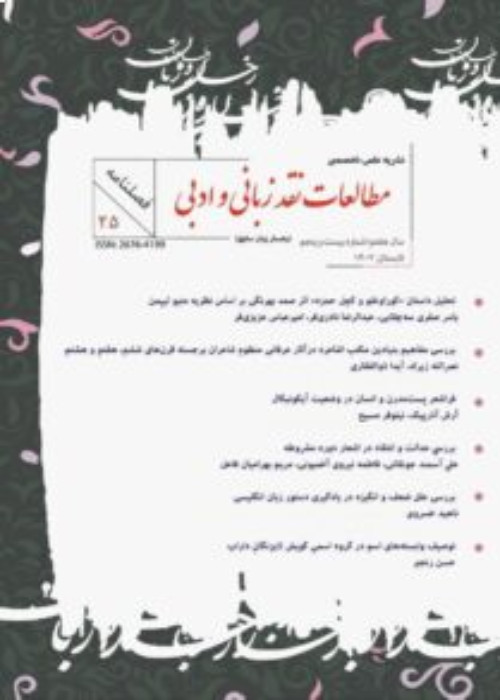فهرست مطالب

نشریه مطالعات نقد زبانی و ادبی
پیاپی 24 (بهار 1402)
- تاریخ انتشار: 1402/09/14
- تعداد عناوین: 6
-
صفحات 5-32
این پژوهش به بررسی نقش زن به عنوان قهرمان و یکی از عوامل گفتمانی در داستان لاک صورتی نوشته جلال آلاحمد میپردازد. پژوهشگر در نظر دارد تا علاوه بر شناسایی جایگاه گفتمانی زن به چگونگی انجام مماشات این عامل گفتمانی با دیگر عامل گفتمانی حاضر در داستان یعنی مرد بپردازد. زن در این داستان در جایگاه کنشگر دارای برنامه قرار گرفته که به دنبال ابژه ارزشی مادی (لاک صورتی) و در نهایت ابژه ارزشی معنوی (جلب توجه و محبت مرد) است. او همچنین به عنوان بوشگر ناراضی از دازاین خود با انجام اقداماتی در طول داستان به دنبال استعلای بوشی است. با توجه به تعریف مماشات گفتمانی مبنی بر تن در دادن یک عامل گفتمانی به بازی عامل گفتمانی دیگر شاهد آنیم که زن در داستان لاک صورتی به عنوان نقش آفرینی مماشات کننده وارد بازی همسر میشود و متاثر از مماشات خواسته خود را نادیده میگیرد. همچنین مماشات بین دو عامل گفتمانی یعنی زن و مرد دوسویه نیست و این تنها زن است که با مماشات حضور خود را نفی میکند و تحت فرمان مرد قرار میگیرد.
کلیدواژگان: نشانه معناشناسی، نظام گفتمانی کنشی، نظام گفتمانی بوشی، مماشات گفتمانی، جل آل احمد -
صفحات 24-50
-
صفحات 51-66
سفرنامه ها به عنوان یک سبک خاص نوشتاری، به دلیل اطلاعاتی که از مکانها، اشخاص و فرهنگ ها ارایه میدهند، دارای جذابیت های ویژهای هستند که مورد توجه مخاطبان قرار میگیرند. توجه عام به این موضوع، محققان را بر آن داشته است تا در سطوح مختلف، به بررسی این سبک نوشتاری توجه نشان دهند. بر همین اساس، پژوهش حاضر به بررسی تطبیقی دو سفرنامه «از پاریز تا پاریس» اثر باستانی پاریزی و «سفر فرنگ» نوشته آل احمد پرداخته است. توجه به جزییات در توصیف وقایع و اشخاص و نثر تلگرافی و انتقادی آل احمد، سبک پژوهشی و نثر فاخر و علمی باستانی پاریزی در تالیف سفرنامه، ضرورت پرداختن به پژوهش را ایجاب کرده است. مسیله اصلی تحقیق این است که کدام ویژگی های سبکی، شاخصه های اصلی این دو سفرنامه را تشکیل داده و آنها را از هم متمایز میکند؟ و آیا سابقه نویسندگی مولفان، در این ژانر بخصوص نمود دارد؟ یافته های پژوهش، حاکی از آن است که شم داستان نویسی و دیدگاه انتقادی آل احمد به امور، کاملا در سفرنامه او متجلی شده است، و سابقه پژوهشی و دانشگاهی باستانی پاریزی، و نگاه ژرف او به تاریخ و فرهنگ در اثرش نمایان است. روش پژوهش حاضر، توصیفی-تحلیلی و مبتنی بر منابع کتابخانه ای میباشد.
کلیدواژگان: سفرنامه، سفرنامه نویسی، از پاریز تا پاریس، سفر فرنگ، ویژگی های سبکی -
صفحات 67-85
یکی از مهمترین مسایلی که همواره مورد بحث قرار گرفته و معضلی لاینحل تلقی میگردد، مسیله اقتباس الفبای فارسی از الفبای عربی است. عموما اینطور در میان عموم مردم و حتی پژوهشگران رایج شده است که ریشه الفبای فعلی ما، برگرفته از الفبای عربی است. این موضوع به اندازهای در طول تاریخ دهان به دهان گشته که ناخواسته تبدیل به حقیقتی غیرقابل کتمان شده است. اما مطالعات زبانشناسی، عکس این مطلب را نشان میدهند. در این مقاله با تکیه بر دو گروه اسناد تاریخی و اسناد زبانشناختی، به واکاوی این موضوع خواهیم پرداخت که الفبای امروز ما برخلاف باور رایج، نه یک الفبای عربی، که برگرفته از رسم الخطهای دوره ساسانی است. در این راستا پس از تحقیق در چگونگی شکل گیری الفبای موسوم به عربی، کوشش شده است تا با بررسی حروف الفبا در سه دبیره مانوی، پهلوی و اوستایی، و تطبیق آنها با الفبای فارسی، این موضوع را اثبات نماییم.
کلیدواژگان: الفبای اوستایی، الفبای پهلوی، الفبای عربی، الفبای فارسی، الفبای مانوی -
صفحات 86-102
تاکید نظریات جدید ادبی بر کاربرد فنون بلاغی و ادبی در سایر متون، این امر را به خاطر میآورد که این اسلوب صرفا مختص به متون ادبی نیست. شباهت هایی که امروزه به قلمرو ادبیات و تاریخ نسبت داده میشود، مرزهای محسوس این دو را دچار خدشه میکند و همگونی و قرابت این دانشها را تصریح مینماید. مورخان برای آنکه اثر خود را به متنی منسجم و خواندنی بدل کنند، از همان عناصری بهره میگیرند که در داستان نویسی کاربرد دارد. لذا چینش، گزینش، حذف و زاویه دید داستان در خدمت اهداف مورخ سامان مییابد. مطابق نتایج یافته شده در این پژوهش، بازگشت به عقب در سیر طبیعی روایت در آغاز جلد ششم به این دلیل منظور گشته تا برای به قدرت رسیدن امیرمسعود غزنوی سابقه ای مطلوب ساخته شود. افزون بر اینکه با منسوب کردن صفات حسنه به مسعود غزنوی، پادشاهی حق طبیعی او قلمداد میشود. بیهقی آغاز مجلد ششم را به گونه ای تنظیم میکند تا مبدا این جلد، که در برگیرنده تاریخ پادشاهی مسعود است، با بررسی صلاحیتهای ذاتی او آغاز گردد، در نتیجه اعمال او در برابر برادرش بدین وسیله مشروعیت یابد.
کلیدواژگان: تاریخ بیهقی، تاریخگرایی نو، داستان، مسعود غزنوی -
صفحات 103-157
-
Pages 5-32
This research examines the woman’s role as a hero and one of the semiotic actants in the story of Lake Surati (Pink Lacquer) written by Jalal Al-Ahmad. In addition to identifying the semotic role of woman, the researcher intends to address the issue of whether woman has discursive appeasement against man and also whether man has discursive appeasement against woman. According to the definition of discursive appeasement that is surrendering of a character in the game of the other we see that the woman enters the role of an appeaser and ignores her desire under the influence of appeasement. Also, appeasement between two discourse agents, i.e. man and woman, is not two-way, and only woman ignores her presence and is under the command of man through appeasement. The woman in this story dissatisfied with her own Dasein, seeks the transcendence. She is also considered an actant who is looking for pink lacquer in a completely planned way, which is considered a valuable material object.
Keywords: Actional regime of discourse, Existential Regime of discourse, DiscursiveAppeasement, Jalal Al-Ahmed -
Pages 24-50
In Naser Khosrow's divan, educational literature and advice are sometimes linked to epic words, metre and rhythm, and have created an epic tone in his poems. Naser Khosrow has made the most advantage of epic and religious allusions, and also used epic words and combinations to create this type of tone. Since tone recognition is directly related to the harmony between style and subject, it should be said that this harmony has been observed to a large extent in Naser Khosrow's poems, because He used his poem as a means for his struggles after his spiritual changes which took place at the age of forty and led him to join the Fatimids. All his life, he has been fighting against the outside world, fighting against the ignorance of the people and fighting with his soul, and he has waged all them in an epic tone that was the best way to express what he said. The statistical population of present study, which is a descriptive-analytical method, is as follows: the highest frequency of about 48% is related to "external war" and "war with ignorance of the people" and the lowest is about 12% of “war with the deceptive time”. Results of this study show that Naser Khosrow not only believed in the influence of the stars and the sky on human destiny, but also he valued human free will more in his own destiny.
Keywords: Structure, tone, epic, Naser Khosrow, poems, words -
Pages 51-66
Because of the title of a special style of writing, Travelogues provide information about places, people and cultures, they have special attractions and they are considered to be a tourist destination. The public attention to this issue has led researchers to point to the investigation of this writing style at different levels. Based on this, the present research has paid a comparative study of ""From Pariz to Paris" and "Journey of Farang"written by Al-Ahmad. Paying attention to the details in the description of events and people, telegraphy writing and criticism of Al-Ahmad, the research style and the artistic style of the ancient Parisian scholar in the travelogue, it is necessary to pay attention to the research. The main question of the research is, what are the stylistic characteristics, the main characteristics of these two works? and what differentiates them from each other? Are writer’s experiences special in this genre? Research findings show that Al Ahmad’s writing story, his critical point of views are visible in his travelogues. Bastani Prizi’s research background at the University of Antiquities in Paris, and his in-depth view of history and culture are well known in his work. The present research method is descriptive-analytical and based on the library resources.
Keywords: travelogue, travelogue writing, from Pariz to Paris, travel to Farang, stylisticfeatures -
Pages 67-85
One of the most important issues that has always been discussed is the adaptation of the Persian alphabet from the Arabic alphabet. Generally, it is common among the public that the root of our current alphabet is derived from the Arabic alphabet. This issue has been so much talked about throughout history that it has inadvertently become an inescapable truth. But linguistic studies show the opposite of this. In this article, relying on two groups of historical documents and linguistic documents, we will analyze the fact that our alphabet today, contrary to popular belief, is not a bare alphabet, which is derived from the scripts of the Sassanid period. In this regard, after researching how the so-called Arabic alphabet was formed, an attempt has been made to prove this issue by examining the letters of the alphabet in the three Manichaean, Pahlavi, and Avestan scripts, and comparing them with the Persian alphabet.
Keywords: Arabic alphabet, Avestan alphabet, Manichaean alphabet, Pahlavi alphabet, Persianalphabet -
Pages 86-102
The Emphasis of New Literary Theories on the Use of Rhetorical and Literary Techniques in Other Texts Reminds Us That, This Style is Not Only Specific to Literary Texts. The Similarities That Are Attributed to the Realms of Literature and History Today Damage the Tangible Boundaries of the Two and Specify the Homogeneity and Affinity of These Knowledges. In Order to Turn Their Work Into a Coherent and Readable Text, Historians Use the Same Elements that Are Used in Story Writing. Therefore, the Arrangement, Selection, Deletion and Perspective of the Story are Arranged in the Service of the Historian's Goals. According to the Results Found in this Research, Going Back in the Natural Course of the Narration at the Beginning of the Sixth Volume Was Meant to Create a Favorable Precedent for Amir-Masoud of Ghaznavi to Come to Power. In Addition, by Attributing Good Qualities to Masoud-Ghaznavi, the Kingship is Considered His Natural Right. Beyhaqi Arranges the Beginning of the Sixth Volume in Such a Way That the Origin of This Volume, Which Includes the History of the Kingdom of Masoud, Begins with the Examination of his Inherent Qualifications, Thus Legitimizing His Actions Against His Brother.
Keywords: Beyhaqi History, New Historicism, Story, Masoud Ghaznavi


